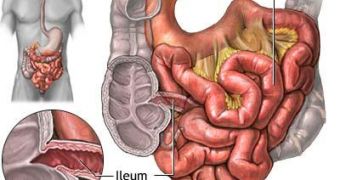1.The small intestine is the part of the digestive tube connecting the stomach to the large intestine. It is an elastic and soft tube made of muscles and membranes, tightly contorted in the abdominal cavity, but with a length of 6 m (20 ft) if stretched. It has 3 parts: duodenum, jejunum and ileum. The duodenum is C-shaped, bound through the peritoneal muscle (a membrane attached to the posterior abdominal wall) to the back part of the abdomen, the other two parts being adherent to the peritoneum in their anterior part only.
2.About 90 % of what we eat is assimilated (enters the blood) in the small intestine. The food that has been chewed and mixed with saliva passes to the stomach. In the stomach, the gastric juice turns it into a liquid easier to digest.
Through the pyloric sphincter, the food is passed from stomach into the duodenum. When the food ball reaches the intestine, the latter divides in two segments through the contraction of the circular muscles. Other muscles encountered between the two segments contract too, dividing the intestine in smaller segments. The first set of muscles relaxes and the result is an action of mincing, known as rhythmic segmentation, which takes place 12 to 16 times per minute.
At the same time, the longitudinal muscle contracts and dilates, resulting an oscillatory movement, that mixes the tube's content with the intestinal juices. The mix is pushed forward by the peristaltic wave, a set of contractions going from the duodenum towards the ileum.
3.Normally, we do not feel the intestine's movements, but, if we eat too much, we can experience a painful sensation and, if we get a food poisoning, we will suffer of violent spasms and pain. Vomits and diarrhea are caused by the irritation of the stomach and intestine caused by toxins.
4.The stomach food ball is extremely acid, containing chlorhydric acid and other digestive enzymes. This acidity is neutralized by the secretions of the small intestine, which contain bicarbonates and alkaline chemicals. Some of these secretions are synthesized by cells from the gut's wall, others by the pancreas or liver (gall). All these chemicals break down food to particles that can be absorbed in the blood.
5.The intestine's walls are thin, but they are folded, so that their surface is large. The surface is sheathed with folds and villosities. In their turn, the cells covering the villosities have small villosities on their surface as well, further increasing the absorption surface.
The food absorbed in the intestine passes into the blood vessels, collected by a large vein going to the liver, from where the nutrients are distributed to the whole body. Fats do not pass directly into the blood, but into the lymph, without passing through the liver.

 14 DAY TRIAL //
14 DAY TRIAL //